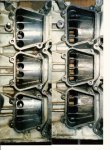Re: what is the proper process/tool to chamfer ports?
I did not have access to a milling machine and did mine by hand. For the squareing operation, the Bridgeport will be MUCH more accurate and is preferable if you have access. The original ports were probably drilled on a modified multi-head Bridgeport that cut all of them in the same pass. But, for the actual tapering and streamlining of the port webs, that probably needs to be done by hand.
On the three cylinder engines, you will see somewhere around 5-10 horsepower gain PER CYLINDER.
Since porting delivers more horsepower but usually at a higher RPM (porting increases the power by allowing more gas flow) for best results you want to be certain that the engine has a 2 to 1 ratio lower unit. Don't overprop and keep the engine up at or near 5500 if you can.
The original Chrysler 90 had a 2-1 lower, some Force 85s have 1.78-1 and some have 2-1.
Chrysler and Force engines are so old school in design that there is a lot of room for improvement by porting. If done correctly there are NO negative consequences, with the exception of possibly a slightly poorer idle. No excess heat is generated and no other systems need to be changed. The only thing you need to be careful about is maintaining exhaust port web thickness so they don't warp. As I said, you keep their thickness on the cylinder side to the same as the distance between the ports. Port size even when enlarged and squared is so small in comparison to the maximum allowed, that catching rings is not a danger. However, chamfering the top and bottom edges is a good idea.
Since gasoline burns at a finite speed and since maximum power is generated when the burn time is equal before and after Top Dead Center and since the burn speed is dependant upon combustion chamber design, timing stays the same.
Compression ratio determines the need for higher octane and since you are not changing that, regular 87 octane is the correct fuel. Now, if you really want to go wild, the head can be milled about .060 for higher compression but then, you would need higher octane fuel.
If your engine has the older round tip reed petals, you can open up the reed stops wider, or you can invest about 125 in a set of aftermarket reeds like Boyeson. I never tried them and can't comment on whether they produce more power.
You do not need to re-jet the carbs, however, check the venturi size: you want to be certain that you have the 1 5/16 venturi carbs. They are marked on the casting internally, just under the float. If you have the smaller 1 3/16 carbs, look around to replace them. Just to be safe, you can set the float level a just a "smidge" high.
Even though at full throttle you will be using more fuel, the stock pump will provide more than enough. Just be sure that there are no restrictions in the system and please, please, please, put a filter BETWEEN the pump and carbs. And, be absolutely certain that they are not set too lean on the low speed circuit. That's the kiss of death to any Force.
However, do not expect magic: After all this, because of the relation of required horsepower to speed--it takes roughly four times the horsepower to double speed--you will only expect to see about 3-5 MPH increase.




















